Strike Detection
Strike detection was not one of the "Keiryu Techniques for Tenkara Anglers" that I spoke about in my presentation at the first Midwest Tenkara Fest. However, had my presentation been after I'd fished there for a couple days instead of before, it definitely would have been. After two amazing evenings fishing in Wisconsin's Driftless Region, I am more convinced than ever before that we are missing many, many strikes.
On the day after the Fest ended, by chance I had a remarkable "test bed" that allowed me to gradually refine a strike detection technique that I wish I could have put into the presentation.
There was this one pool, the likes of which I will probably never see again. The first time I fished it, there were five of us who fished that one pool continuously for at least three hours. The fish never stopped biting.
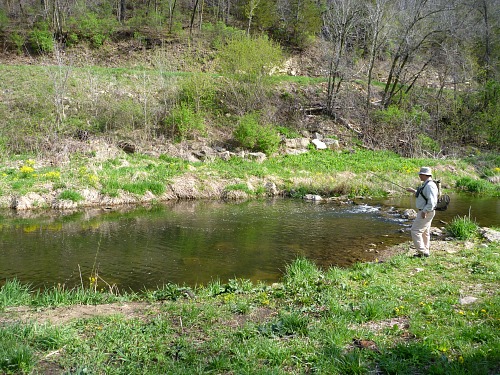 Matt Sment fishing the "miracle pool."
Matt Sment fishing the "miracle pool."I returned the following evening, after everyone else had gone their separate ways. I started fishing with salmon eggs, and literally caught a fish on every single cast. After a while (and after enough fish that I lost count) I switched to Killer Bugs tied with Jamieson's Shetland Spindrift "Sunglow" yarn yarn. I no longer caught a fish with every cast, but it was only after I switched to flies that I learned the most significant lesson of the weekend.
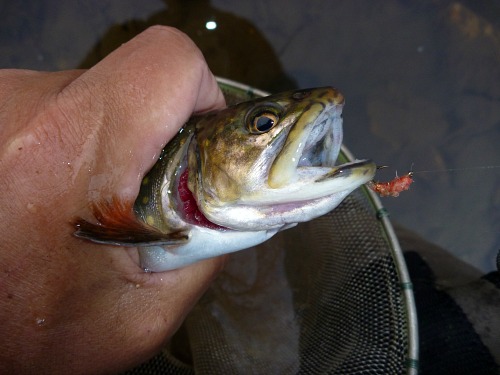
First, a bit of background info: When the five of us (there may even
have been six - my mind was on the fish) were fishing the pool, the two
keiryu anglers - Craig Thoreson and myself - outfished the tenkara
anglers at least 5 to one. (It's not bragging if it's true - and
besides, the point is not that Craig and I caught a lot of fish, it's
that the tenkara guys didn't catch the fish that were there and were
hungry). To be fair, they did catch some fish both at that time and previously, but they didn't catch nearly as many (and there were more of them).
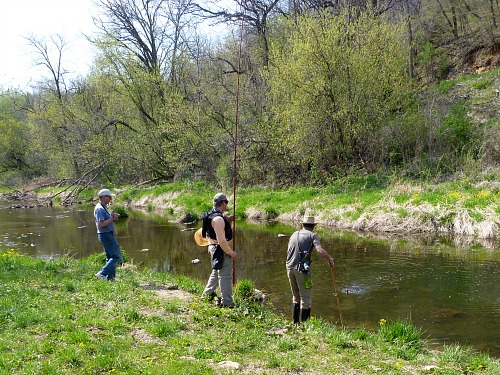 Dave Noll looks on as Alan Luecke prepares to net one of Craig Thoreson's catches.
Dave Noll looks on as Alan Luecke prepares to net one of Craig Thoreson's catches.That is not in any way a swipe at their skills as tenkara anglers - or a swipe at tenkara relative to keiryu. Keiryu fishing clearly does have an advantage when it comes to catching fish, though. Fish are not going to spit out bait unless there is significant tension on the line. That makes strike detection relatively easy. You have to react quickly or they will swallow it, though (and I confess I was not always quick enough on the previous evening - it turns out trout seem to swallow salmon eggs more quickly than the worms or waxworms I had previously used while keiryu fishing, perhaps because they are so much smaller and "bite sized").
The point is that tenkara anglers and fly fishermen have a much harder time with strike detection because the fish will realize that the fly is fake and spit it out. They can do that with astounding speed. I distinctly remember an instance years ago when fishing a very small pool in a very clear stream. On that occasion, I saw four separate trout hit my fly and spit it out, all within the space of three or four seconds. The line didn't so much as quiver and I didn't feel a thing. I was so surprised I didn't even try to set the hook. I knew trout were fast. I had no idea they were that fast.
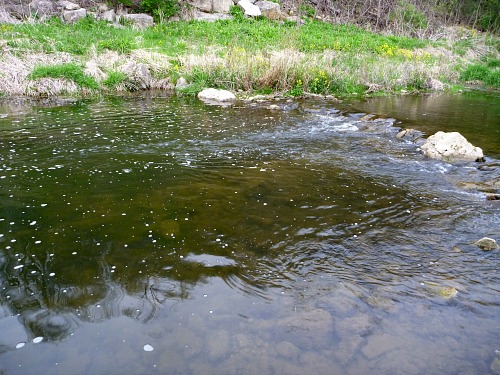 Head of the pool
Head of the poolIn the pool we fished at the Fest, there was very little current other than at the head of the pool and just a little ways into the very center of the pool. I think that creates a very difficult scenario for fishing subsurface flies.
Fishing wet flies (and nymphs) is easier if there is more current. The fish will be holding in quiet water, either in front of or behind a rock, log, etc. - something that allows them to hold their position without expending too much energy. When they take a fly drifting past, they will often dart out into the current, take the fly and dart back to the quiet water. That not only interrupts the drift of the fly, causing your line to stop, it often causes the line to move to the side or even forward a bit. In those cases, strike detection is easy.
Sometimes, though, the fish will drift back with the fly, examining it more closely before taking it or rejecting it. Those takes are more subtle, as the fish and the fly are drifting at the same speed so the take doesn't cause the line to stop. The fish isn't darting out and back, so there may not be any sideways twitch either.
Strike detection is the hardest, though, are when there is little current at all, and the fish can hit the fly, realize that it is fake, and spit it back out causing little or no change in the movement or position of the fly. That may be why tenkara anglers in Japan pulse their fly when it is in an eddy. The action probably makes the fly more attractive, but it certainly creates a speed differential between the fly and the fish. Also, I now think that fish will hit a moving fly more aggressively if they think it is "getting away" and thus they will either make your line twitch, cause a swirl at the surface or show a flash as they hit the fly and turn. If you watch the Japanese videos closely, the fly is almost always in quiet water when they are pulsing, not in the main current.
Getting back to the pool and the strike detection lesson - when I returned the second evening and had the pool to myself, I cast just downstream of the rocks at the head of the pool, letting the bait or fly drift with the current into the middle of the pool. I rarely had to wait very long before a fish hit.
Because I had been a bit slow in striking the previous evening, I made a point of striking earlier. Part of the reason I had been slow on Sunday evening was that my line was long enough that the split shot would occasionally hit a rock or hang up on the bottom and I waited just a bit for confirmation that it was a fish rather than a rock. That was a mistake.
On Monday I shortened the line to the point that I wasn't hitting the bottom and didn't have any "false positives" - signs of a take that turned out to be rocks instead of fish. I also didn't have any deep hooked fish. With the salmon egg, and later the fly, drifting a bit above the bottom, it seemed like a lot of the fish came up to take it, and then went back down. The line dipped on a take.
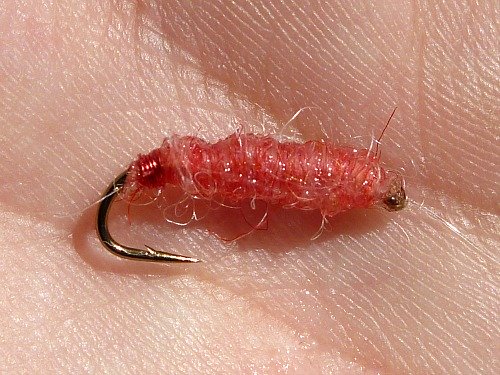 Killer Bug tied with Jamieson's Shetland Spindrift "Sunglow" on a Daiichi 1560 nymph hook size 12. At the pool, I was using one tied on a Daiichi 1120 scud hook, size 14
Killer Bug tied with Jamieson's Shetland Spindrift "Sunglow" on a Daiichi 1560 nymph hook size 12. At the pool, I was using one tied on a Daiichi 1120 scud hook, size 14That laid the groundwork for the lesson - which was strike detection when fishing flies. Immediately after I switched from salmon eggs to flies - which was just to see if the Killer Bugs would work, I felt I was getting many fewer hits - which certainly fit my bias that bait would yield more hits than flies. I missed a fair number of hits, though, so I kept trying to strike more quickly and to strike at more subtle indications of a take.
What made this pool such a great test bed is that I could vary my reaction to strikes with everything else held constant. I was fishing the same water, standing in the exact same place - everything was exactly the same - and I could see and feel the results on the very next cast.
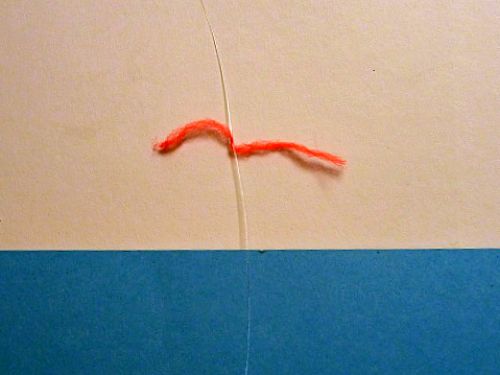 Single keiryu marker, long tag ends,
Single keiryu marker, long tag ends,kept about 2" above the water's surface.
The system I used to indicate strikes is extremely unconventional. Keiryu anglers in Japan use "markers" on their lines, either thin polypropylene yarn or small plastic flags. Of the two, I much prefer the yarn because it is light enough that it doesn't cause line sag. The Japanese will use three or four markers that are tied around the line and have the tag ends cut relatively short, generally a half inch or less, sometimes much less. The single yarn marker I used on Monday had tag ends that were over an inch long.
One advantage of multiple markers is that it is much easier to see if your line stops because that changes the angle and possibly the curvature of the line. Three or four markers will show a change in angle or curvature, but a single marker cannot. Also, shorter tag ends reduce the wind resistance that is experienced on the cast, although using only one long marker rather than four shorter ones balances that out at least a bit.
It turned out, though, that the "wind resistance" of the very long tag ends was an advantage. When the line dipped from a fish taking the fly or bait, the knot in the center of the marker dipped with the line but the resistance of the air caused the ends of the very light yarn to stay relatively still, turning a straight line marker into a "V" shape. It was easy to see even the slightest dip or sideways movement in the line because the shape of the marker changed. The center knot was quite mobile, the ends were much, much more stable.
I have been criticized before, and surely will be again, for not following the Japanese masters. The three or four marker convention was probably honed over decades if not centuries. I am sure there are very good reasons why the Japanese do not use a single, long-tailed marker like I did, but let me tell you, it worked and without it I am certain I could not have detected many of the most subtle hits.
If I had to guess, I'd guess the primary reason keiryu anglers have not used a single, exquisitely sensitive marker is because they were bait fishermen, and the need for extreme sensitivity only occurs if you are fishing flies, which the fish will spit out almost immediately. If you are fishing with bait and your modus operandi is hook and cook rather than catch and release, there is no great need for speed because if you are going to kill the fish anyway, it doesn't matter if it swallows the hook.
What I gradually came to notice, and it took many, many takes to realize it, was that I was getting more hits on the fly than I was on the salmon egg! The only way that could be, since I got a hit on every single drift with the salmon egg, was that if I didn't react in time to a hit on the fly and the fish spit it out, I got a second or even third hit later in the same drift.
That realization came in retrospect. As I gradually realized that the takes were more subtle than I had been expecting I reacted more quickly to clues. As I became more sensitive to minute twitches in the ends of the yarn marker I detected more hits - and realized that movements I had put down to current variations or my own inability to hold the rod perfectly steady were in reality caused by fish hitting the fly.
To clarify, it wasn't really the ends of the marker that were twitching, it was the center of the marker moving and the ends staying pretty stable. Basically, it was the shape or orientation of the marker that was changing. When a fish was hooked and you could feel the head shakes, the marker looked like a butterfly flapping its wings.)
Some of the hits were incredibly subtle and as sensitive as I tried to become, even by the end of the evening I had no reason to believe I was detecting all the hits.
One thing that definitely surprised me was that late in the session, when I was the most "tuned in" to the extremely subtle changes in the shape of the marker, I realized I was not just seeing the takes, I actually could feel all the takes in the rod.
I had always thought while tenkara fishing that if you wait until you feel a strike you will be missing many strikes. With tenkara, I generally watch the end of my hi-vis line and see many more strikes than I feel. On Monday evening, I was fishing the Suntech ZPRO rods (since discontinued, but very similar to the newer Suntech PROSPEC RC (soft) rods, which are very long, very light and very sensitive.
The main difference between the way I was fishing that evening with my long keiryu rods and the way the tenkara guys were fishing the previous evening was that my line was very nearly vertical where it entered the water. That was a point I had stressed in my presentation at the Fest a couple days earlier. At the time, though, the point I was making was that a vertical entry greatly reduced the drag caused by current differentials. I didn't even mention increased sensitivity.
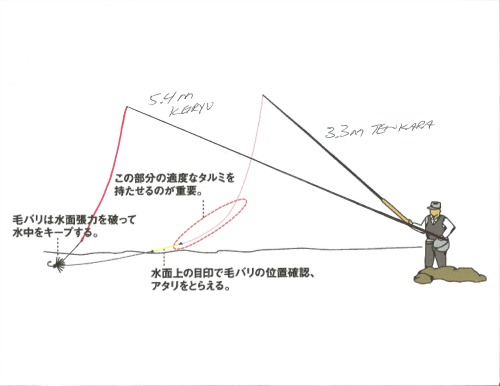
The illustration above is one I used in my presentation, comparing how much tippet is in the water when fishing with a shorter rod and longer line compared to a longer rod and shorter line. With even just a meter of tippet in the water, tenkara fishermen are often subject to drag caused by current differentials. That same fly fished on a longer keiryu rod would be much less susceptible to drag.
What I had not noticed previously was how incredibly sensitive the rods are to the slightest tap on a straight, nearly vertical line. On the relatively few times when I had previously fished with an essentially vertical line, strike detection was easy. The takes I noticed were far from subtle. In one case the rod tip dove by at least a foot as the trout that came out to take my fly headed back for cover.
With a longer tenkara line and the resultant line sag, much of any subtle "tap" will be absorbed by the slack in the line so strike detection by feel will be much, much harder.
I believe the reduced sensitivity caused by line sag is the primary reason the tenkara anglers on Sunday did not catch nearly as many fish as did the keiryu anglers. Craig and I had been fishing 7 meter rods with extremely light lines that were very nearly vertical. The tenkara anglers were fishing rods about half that long with much heavier lines and the unavoidable line sag that robbed much of their rods' sensitivity.
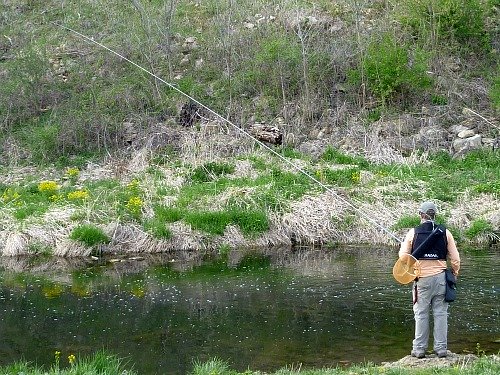 Craig Thoreson trying my 7 meter Daiwa EP Zero 01-70M.
Craig Thoreson trying my 7 meter Daiwa EP Zero 01-70M.In my presentations at the Winter Series in Colorado in March and at the Midwest Tenkara Fest in May, I spent quite a bit of time talking about using long rods and short lines, strongly suggesting that they will produce better drifts than shorter rods and longer lines. What I sadly was not aware of previously is that a light, nearly vertical line together with an extremely sensitive "indicator" (in this case an unconventionally applied keiryu marker) can detect strikes that are much more subtle than you could imagine.
To be honest, I was shocked - not only at how subtle a strike I could detect, but also that Killer Bugs yielded the same 100% strike per drift ratio as did salmon eggs. To repeat an earlier comment, I do not expect to ever fish a similar "miracle pool" again. I do not expect to get a hit on every drift. However, with a longer rod, a shorter line and an expectation that the hits will be extremely subtle, I do believe I'll catch a lot more fish.
I do not think you need a 7 meter "Zero" rod to experience that degree of sensitivity. At the end of the evening, I was fishing a Suntech Suikei ZPRO 54, which I have previously used quite successfully on even relatively modest streams such as the one below. It has been discontinued, but the Suntech PROSPEC RC 52 (soft) would do just as well, as would a Suntech Kurenai HM54R if the fish are of modest size. Both rods have extremely soft tips, which will "give" easily, so that your marker can dip without the fish feeling much tension on the line.
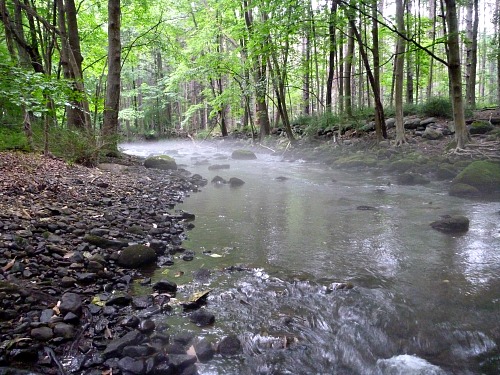
I do think you will want a rod longer than any of your tenkara rods, though. To be able to fish with a nearly vertical line and still fish far enough away that your very presence doesn't scare the fish, I think you will want at least a 5.4m rod.
From very early on, I've suggested fishing with the longest rod you can get away with. I'm still learning how valuable that thought is.
TenkaraBum Home > Tenkara Rods > Strike Detection
“The bitterness of poor quality remains long after the sweetness of low price is forgotten” - Benjamin Franklin
"Be sure in casting, that your fly fall first into the water, for if the line fall first, it scares or frightens the fish..." -
Col. Robert Venables 1662
As age slows my pace, I will become more like the heron.
Warning:
The hooks are sharp.
The coffee's hot.
The fish are slippery when wet.
Beware of the Dogma
What's in stock?
Suntech Tenkarakyo 40F Tenkara Rods
Suntech Kurenai II AR39F
Seiryu Rods
Coming Soon
Latest Pages
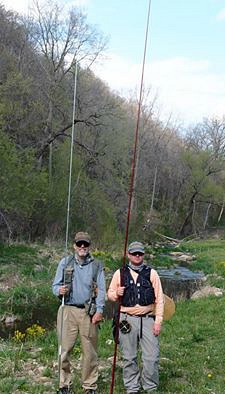
With Craig Thoreson and our
7 meter rods. Photo: Dave Noll
If you enjoy spin fishing or baitcasting please visit my sister site Finesse-Fishing.com.


